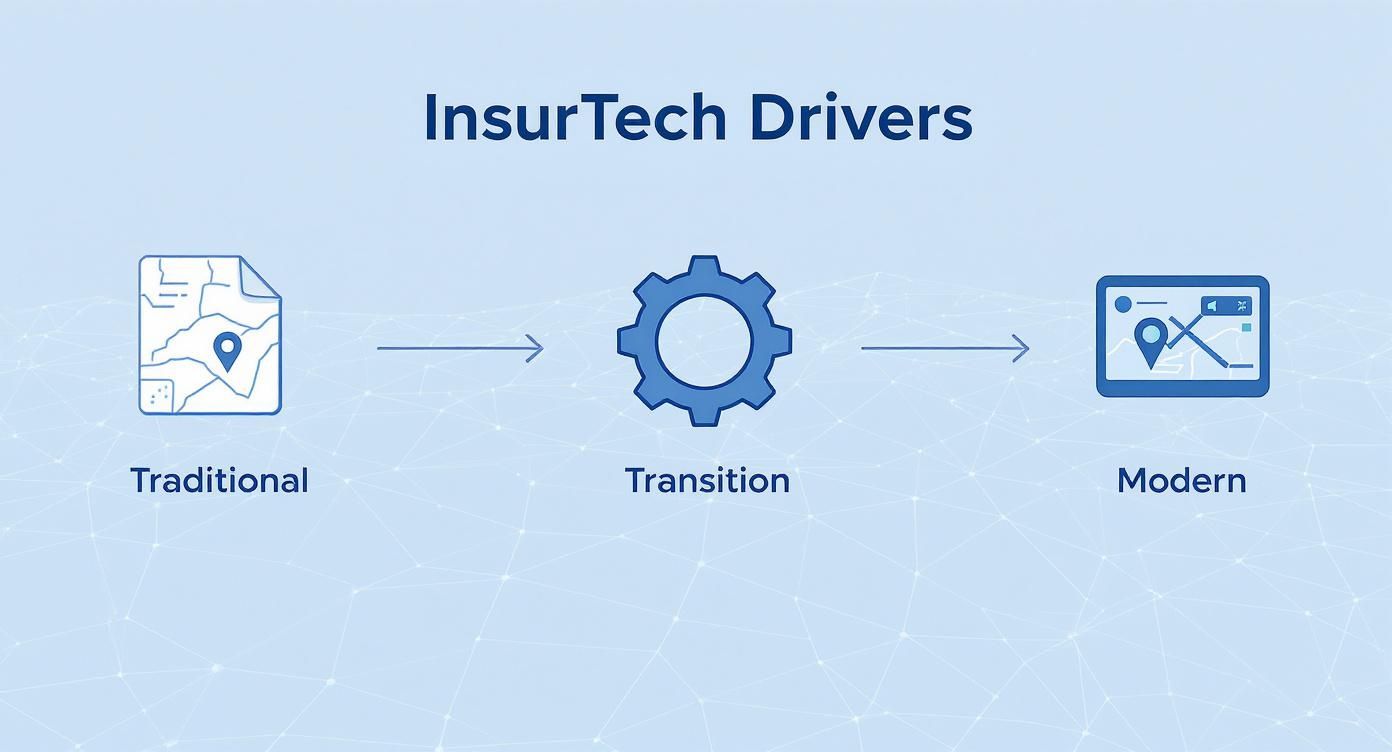At its heart, Canadian insurance technology, or InsurTech, is all about using modern digital tools to overhaul the way insurance works. Think of it as a shift from the old world of paper files and manual processing to a smarter, faster system built on AI, cloud computing, and automation.
It’s less of an upgrade and more of a complete rethinking of the business, putting efficiency, data, and the customer experience front and centre.
The New Landscape of Canadian Insurance
Technology is no longer just a supporting player in Canadian insurance; it's the main act. The industry is moving away from its traditional, often sluggish, manual roots toward intelligent, automated systems. It’s like trading in a dusty old road atlas for a live GPS that reroutes you around traffic in real time.
What’s pushing this change? It really boils down to two things. First, customers have come to expect instant, digital-first service in every part of their lives, and insurance is no exception. At the same time, insurers are under constant pressure to cut costs, boost efficiency, and simply keep up.
Forces Shaping the Market
Several key pressures are reshaping how Canadian insurers do business:
-
Heightened Customer Demands: Today’s policyholders expect the same seamless experience from their insurer that they get from their favourite retail or banking apps. They want quick quotes, easy-to-use mobile tools, and fast, transparent claims processing.
-
The Need for Efficiency: The days of manual data entry, slow underwriting, and mountains of paperwork are numbered. Automation isn't a luxury anymore; it's essential for cutting operational costs and letting skilled teams focus on complex, high-value work.
-
Economic Pressures and Resilience: The Canadian insurance market isn't immune to economic headwinds. For instance, a notable slowdown in mergers and acquisitions, with deal volume dropping from 129 in 2022 to a projected 100 in 2024, signals a more cautious climate. You can dig into the numbers in the Canadian insurance brokerage M&A market update from MarshBerry. In this kind of environment, technology becomes the key to building a more resilient business and unlocking new growth opportunities.
This chart from PwC clearly shows what's on the minds of insurance CEOs today, with a major focus on reinventing their companies through technology and talent.
The data really drives the point home: technology is woven into almost every strategic goal, whether it’s managing costs, delighting customers, or navigating new regulations. Getting the technology right is seen as the clearest path to becoming a more agile and customer-focused insurer.
Technology is not just about upgrading old systems; it's about reimagining the entire insurance value chain. From risk assessment to customer engagement, digital tools are creating opportunities for innovation that were unthinkable a decade ago.
The push toward artificial intelligence is especially strong. To get a sense of its wider impact, it’s worth understanding the trends around AI adoption in Canadian enterprises across the board.
In the end, Canadian insurers aren't just adopting technology to stay afloat. They're using it to build a fundamentally stronger, more responsive, and more competitive industry for the future.
The Core Technologies Remaking Canadian Insurance
To really get what’s happening in Canadian insurance, you have to look under the hood at the tools making it all possible. We're moving far beyond the old world of paper forms and manual calculations. The industry is being rebuilt on a foundation of intelligent, data-driven technologies, and each one plays a unique role in making insurance faster, smarter, and more responsive.
It's not just a minor update; this is a fundamental shift in how insurance companies operate and serve their customers.

This image really drives home the journey we're on, from static, reactive processes to a dynamic, predictive model where technology is the clear catalyst for change.
Artificial Intelligence and Automation
Artificial Intelligence (AI) is like having a team of brilliant detectives and hyper-efficient assistants working 24/7. In the Canadian insurance space, AI algorithms can sift through massive datasets in a blink, spotting subtle patterns a human underwriter might take days to find, or miss entirely. This leads to far more accurate risk assessments and pricing.
A perfect example is fraud detection. AI can instantly flag a suspicious claim by catching inconsistencies between a police report and a claimant’s statement, or by comparing a new claim against a huge database of known fraudulent patterns. This doesn't just save insurers millions; it helps keep premiums affordable for everyone else.
Working alongside AI is Robotic Process Automation (RPA), which you can think of as a digital workforce. RPA takes on the repetitive, rules-based tasks that often create bottlenecks for insurance teams. It's perfect for things like:
-
Routine claims processing: Automatically pulling information from digital forms and plugging it into the right systems.
-
Policy renewals: Checking data, generating renewal documents, and sending out notifications without a human lifting a finger.
-
Data entry: Moving information between different platforms accurately, freeing up skilled employees to focus on more complex, high-value work.
By automating these essential back-office jobs, Canadian insurers are cutting operational costs and getting things done much, much faster.
To get a clearer picture, let's break down how these technologies fit into the bigger picture.
Key Technologies and Their Impact on Canadian Insurance
| Technology | Primary Function in Insurance | Key Benefit for Insurers |
|---|---|---|
| AI & Machine Learning | Analyzes vast datasets to predict risk, detect fraud, and automate underwriting decisions. | More accurate pricing, reduced fraudulent payouts, and faster decision-making. |
| Cloud Computing | Provides scalable, secure, and on-demand access to data, software, and infrastructure. | Greater operational flexibility, lower IT overhead, and improved data accessibility. |
| Telematics & IoT | Collects real-time data from vehicles and properties to monitor risk and behaviour. | Enables usage-based insurance (UBI), proactive risk prevention, and personalized pricing. |
| Automation (RPA) | Executes repetitive, rules-based tasks like data entry and claims processing. | Increased efficiency, reduced human error, and lower administrative costs. |
| Blockchain | Offers a secure, decentralized ledger for transparent and tamper-proof record-keeping. | Enhanced fraud prevention, streamlined claims verification, and greater trust in transactions. |
This table shows how each piece of technology serves a distinct purpose, yet they all work together to create a more modern and efficient insurance ecosystem.
The Power of Cloud Computing
If AI is the brain of a modern insurer, then cloud computing is its central nervous system. Instead of being locked into rigid, expensive on-premise servers, cloud platforms give insurers a secure, flexible, and accessible home for all their data and applications. This shift has been a complete game-changer.
Insurers can now access mission-critical information from anywhere, which is essential for supporting remote teams and empowering agents in the field. More importantly, the cloud allows a company to scale its computing power up or down as needed. This means they can launch a new product or handle a massive surge in claims after a storm without having to buy and install costly new hardware.
Moving to the cloud isn't just another IT project; it's the foundational step for any insurer serious about modernization. It provides the secure, scalable backbone needed to run everything else, from AI analytics to real-time IoT data streams.
It's no surprise that Canadian insurers are investing heavily here. A recent PwC survey found that 52% of insurance CEOs see AI as a critical driver of profitability. At the same time, 74% of those CEOs point to cybersecurity as a major threat, which highlights just how important it is to get the transition to new, secure systems right.
Telematics and The Internet of Things (IoT)
This is where insurance gets personal and proactive. Telematics and IoT are all about using small sensors in cars, homes, or even businesses to collect real-time data and send it back to the insurer. This constant stream of information creates incredible new ways to manage risk.
In auto insurance, telematics devices track real-world driving habits:
-
How fast someone drives
-
Harsh braking or acceleration
-
What time of day they're on the road
-
Total kilometres driven
This data fuels Usage-Based Insurance (UBI), where premiums are tied directly to how you actually drive. It's a much fairer system that rewards safe drivers with lower costs and is one of the most visible examples of Canadian insurance technology at work.
As these core technologies mature, they enable insurers to implement more sophisticated and innovative risk management solutions. In property insurance, IoT sensors can monitor for a water leak, a sudden temperature drop that could freeze pipes, or smoke. They can alert both the homeowner and the insurer before a small issue becomes a full-blown disaster. You can also read more about how generative AI is used in the insurance industry to see how these technologies are evolving. This proactive approach to preventing losses is a true win-win: insurers pay out fewer claims, and customers get to protect their most valuable assets.
Navigating Canadian Regulatory and Privacy Hurdles

In Canada, bringing new technology into the insurance world isn't just about innovation; it's about weaving that innovation through a complex web of compliance. You simply can't have one without the other. The country’s distinct regulatory environment means any new system, especially one handling sensitive client data, needs to be built with a "compliance-by-design" mindset from the ground up.
This means any tech solution must be smart enough to navigate local rules right out of the box. Take, for instance, understanding the nuances of Ontario's No-Fault Insurance system, which fundamentally changes how claims are processed. You can't just plug in a generic platform and hope for the best; the technology has to be tailored to work within these specific legal frameworks.
Understanding PIPEDA and Data Privacy
At the core of Canada's data privacy landscape is the Personal Information Protection and Electronic Documents Act (PIPEDA). Think of it as the national rulebook for how private companies, including insurers, must collect, use, and protect personal information. It's not a guideline, it's federal law.
For any insurer, this has direct implications for technology. Whether you're adopting a new CRM or an AI-powered claims tool, it must be engineered to:
-
Get clear consent: Customers need to know precisely what data you're collecting and why you need it.
-
Collect only what's necessary: You can’t just grab all the data you can; collection must be limited to the specific purpose you’ve stated.
-
Keep it accurate: The information you store has to be correct, complete, and current.
-
Give customers access: People have a right to see the data you have on them and ask for corrections.
Getting this wrong isn’t just a trust issue. It can lead to steep financial penalties and a public relations nightmare.
The Critical Issue of Data Residency
Hand-in-hand with privacy is the matter of data residency, in other words, where your data physically lives. While PIPEDA doesn't have a hard-and-fast rule against storing data outside Canada, many provincial regulations and client expectations create a strong push to keep Canadian data on Canadian soil.
Once personal information crosses a border, it becomes subject to the laws of that country. This can open up a can of worms regarding legal and privacy risks that most Canadian insurers would rather avoid, making data residency a make-or-break factor when choosing a technology partner.
This is a non-negotiable question to ask any potential vendor. Where are their servers? What guarantees can they provide that your clients' data will stay within Canada? Partnering with a provider that has established Canadian data centres is almost always the safest and most straightforward route.
Meeting OSFI Guidelines with Technology
For federally regulated insurers, the Office of the Superintendent of Financial Institutions (OSFI) sets a high bar for operational resilience and risk management. These guidelines are no longer just about financial health; they're increasingly focused on technology risks, from cyber threats to the impacts of climate change.
Guideline B-15, for example, deals with climate risk management. Insurers are now expected to use sophisticated models to grasp and prepare for the financial fallout of climate-related events. Modern insurance technology is the only way to meet these demands, allowing insurers to crunch massive datasets and make informed decisions.
As the Canadian insurance sector, projected to hit a market size of US$121.25 billion by 2025, navigates these challenges, the pressure to adopt more advanced tech will only grow. This evolving landscape requires a sharp focus on both innovation and airtight compliance, especially as threats multiply. A huge piece of that puzzle is understanding the specific challenges of cybersecurity in the insurance industry.
Real-World Canadian Insurance Technology Success Stories

It's one thing to talk about what technology could do, but the real proof is what it's actually doing on the ground. Across Canada, insurers and brokers are seeing real, tangible returns on their tech investments, moving well beyond the pilot project phase. We're not talking about small tweaks here; these are fundamental improvements to how they operate and connect with customers.
From regional brokerages to national carriers, success stories are popping up everywhere. These examples aren't just hypotheticals; they show how smart tech adoption is solving old problems and delivering results you can measure.
Slashing Claims Settlement Times with AI
Claims processing has always been a bottleneck; slow, manual, and frustrating for everyone involved. But that’s changing. A major national insurer brought in an AI-powered claims triage system to speed up the entire process, right from the First Notice of Loss (FNOL) to the final payment.
Before this, a standard property claim could easily take weeks to sort out, bogged down by manual reviews and endless data entry. The new system, however, uses AI to instantly scan claim documents, photos, and reports as they come in. It figures out the claim's severity, flags anything that looks suspicious, and gets it to the right adjuster with all the key information already filled out.
The impact was immediate and pretty staggering:
-
Faster Settlements: The average time to close simple-to-moderate claims dropped from 21 days to just 3 days.
-
More Productive Adjusters: With administrative work off their plates, adjusters could handle 30% more claims each month and focus on the complex cases that really needed their expertise.
-
Happier Customers: Policyholder satisfaction scores for the claims experience shot up by 18%. Speed and transparency made all the difference.
This is a perfect example of how AI complements human skills. It doesn't replace the adjuster; it empowers them to be faster, smarter, and more effective.
Boosting Client Retention Through Automation
Out in Western Canada, a mid-sized brokerage was struggling with client churn. Their approach to renewals and communication was all manual, which meant things were inconsistent and opportunities were being missed. They were always reacting, never getting ahead.
They decided to bring in a Client Relationship Management (CRM) platform built for the insurance world. This system connected with their existing software, giving them a single, clear view of every client.
By automating routine touchpoints and giving brokers timely, relevant insights, the right technology can turn client service from a simple transaction into a proactive, relationship-building engine. This is exactly what modern Canadian insurance technology is all about.
The brokerage set up automated workflows for critical client interactions:
-
Renewal Reminders: Personalized emails and texts now go out 90, 60, and 30 days before a policy is up for renewal, giving clients a friendly nudge to connect.
-
Cross-Sell Opportunities: The system flags clients who have home but not auto insurance (or vice versa), prompting the broker to reach out with relevant information.
-
Client Check-Ins: Simple things like automated "happy birthday" messages and annual policy review reminders helped them stay connected all year round.
The result? In the first year alone, the brokerage saw a 22% increase in client retention. The automation freed up a ton of administrative time and, more importantly, ensured no client ever felt forgotten. It’s a powerful lesson in how technology can actually strengthen human relationships, not replace them. These examples aren't outliers; they're the new standard for practical, profitable technology adoption in the Canadian insurance sector.
A Strategic Tech Roadmap for Canadian Insurers
For many small and mid-sized insurers, the idea of a "digital transformation" can be overwhelming. It often feels like you're being asked to rebuild the plane while it's already in the air. The secret isn't to chase every new trend, but to follow a grounded, step-by-step plan that makes sense for your business. A good roadmap turns a massive, intimidating project into a series of manageable, value-driven steps.
The journey doesn't start with flashy technology. It starts with your biggest operational headaches. What are the most time-consuming, frustrating, or error-prone parts of your team's day? Is it the mind-numbing manual data entry for new policies? Or perhaps the slow, multi-step dance just to generate a simple quote? Nailing down these real-world pain points is the single most important first step.
Phase 1: Identify and Prioritize Your Biggest Challenges
Before you even start looking at solutions, you need a crystal-clear diagnosis of the problem. Get your team in a room, brokers, underwriters, claims processors, and admin staff, and start mapping out your current workflows. The whole point of this exercise is to find the friction.
A "pain matrix" is a great tool for this. Simply list each operational issue and rate it on two scales: its impact on the business (think lost time, client frustration, or hard costs) and how often it happens. The problems that end up in the "high-impact, high-frequency" corner are your top priorities. This quick exercise brings immediate clarity and shows you exactly where to focus for the biggest and fastest return.
Phase 2: Build a Compelling Business Case
Once you have your target, you need to build a rock-solid case for investing in a solution. This isn't about creating a laundry list of software features; it's about tying the technology directly to business results. Your business case needs to answer the "why" behind the investment, loud and clear.
Zero in on tangible metrics:
-
Cost Savings: Figure out the hours saved by automating a manual process and put a dollar figure to it. For instance, if automation saves 10 hours per week for a team of five, that’s a significant operational win you can quantify.
-
Increased Revenue: Show how a quicker quoting system could boost your conversion rate, or how a good CRM could improve client retention by a specific, measurable percentage.
-
Improved Compliance: Explain how a new system can cut down on human error and make meeting regulatory requirements a more efficient, less stressful process.
A strong business case doesn't just ask for money. It presents a clear, data-backed vision of a more efficient and profitable future, turning a technology purchase from an expense into a strategic investment.
This document becomes your North Star. It guides the project, helps you get buy-in from leadership, and acts as the bridge between a good idea and a funded initiative.
Phase 3: Start Small with Pilot Projects
Diving headfirst into a company-wide rollout is a classic mistake and often a recipe for disaster. The much smarter approach is to begin with a small, controlled pilot project. Think of it as a test flight. You can try out a new piece of Canadian insurance technology with just one team or for a single product line to see how it performs in the real world.
This method takes a huge amount of risk off the table. It lets you iron out the kinks, get honest feedback from actual users, and prove the value on a small scale before you commit to a bigger investment. A successful pilot creates momentum and, just as importantly, creates internal champions who will help you drive wider adoption down the road. This way, your digital shift is a steady, value-driven evolution, not a disruptive overhaul.
Choosing the Right Technology Partner for Your Journey
The promise of insurance technology is massive, but all that potential means nothing without a solid implementation. This leads every insurer and brokerage to a crossroads: do you build a custom solution from the ground up, buy something off the shelf, or bring in a specialized firm to steer the ship? There's no single right answer;c the best path forward depends entirely on your specific goals and what resources you have at your disposal.
Trying to make this call alone can be overwhelming. The tech is complex, the market is crowded with vendors, and Canada's regulatory environment is notoriously strict. This is precisely where a strategic technology partner proves its worth.
More Than Just Coders
A real partner does so much more than write code or install a piece of software. They become your guide for the entire journey, from the initial brainstorming sessions all the way to launch day and beyond. Think of them as the architect and general contractor for your digital build-out, making sure every component is built to spec, on schedule, and perfectly aligned with your vision.
A dedicated development partner like Cleffex brings a few critical things to the table:
-
Strategic Guidance: They'll help you dig into your operational headaches and chart a course that tackles the biggest problems first for the greatest impact.
-
Vendor Agnostic Advice: A good partner can look at off-the-shelf products objectively and tell you which one fits best, or, more importantly, when a custom build is the smarter move.
-
Regulatory Expertise: They already know the ins and outs of PIPEDA, data residency laws, and OSFI guidelines, so compliance is baked in from the start.
Partnering with a specialist takes a huge amount of risk off the table. Instead of taking a gamble on a solution that might miss the mark, you get a collaborator who is fully invested in understanding your business and the unique realities of the Canadian insurance market.
The Build Versus Buy Decision
This is usually the first big question you'll face. An experienced partner can help you see the pros and cons clearly.
Buying an off-the-shelf solution is often quicker to get up and running and can seem cheaper upfront. The catch? It might not be flexible enough for your specific way of doing things, forcing your team to change how they work just to accommodate the software.
Building a custom solution, on the other hand, is made to measure. It’s designed around your exact processes, connects smoothly with the systems you already use, and can give you a real edge over the competition. The initial investment might be higher, but the return over the long haul is often much greater.
In the end, picking the right partner is about finding a team that gives you the confidence to navigate these decisions. That collaboration gets you to market faster, makes sure your tech is ready for what's next, and turns a complicated project into a clear roadmap for growth.
Frequently Asked Questions
It's natural to have questions when you start looking into modernizing your insurance operations. Exploring new technology often brings up concerns about everything from the real cost to the impact on your team. Let's tackle some of the most common questions we hear from Canadian insurers and brokerages.
What is the Real Cost of Adopting New Insurance Technology?
The sticker price is never the whole story. The true cost includes software licenses, implementation work, and, just as importantly, the time you'll invest in training your team. A small brokerage might find that an off-the-shelf CRM system comes with a predictable monthly fee. A larger insurer building a custom AI-powered claims system, on the other hand, is looking at a major capital project.
The right way to think about it is in terms of return on investment (ROI). If a new automation tool saves your team 15 hours a week on mind-numbing data entry, you can put a real dollar value on that. You have to weigh the initial outlay against the long-term wins: better efficiency, happier clients who stick around, and fewer operational headaches.
How Secure is My Client Data in the Cloud?
Data security is paramount, so this is a completely valid concern. The good news is that reputable cloud providers serving the Canadian market pour millions into security measures that far exceed what most individual insurers could manage on their own. We're talking about state-of-the-art encryption, routine third-party security audits, and entire teams dedicated to watching for threats 24/7.
The single most important question you can ask a potential tech partner is about data residency. You need to ensure your client data stays on servers physically located within Canada. This is the clearest path to complying with privacy laws like PIPEDA and giving everyone peace of mind.
Will Automation and AI Replace Insurance Professionals?
This question comes up a lot, but the reality is much more positive. Technology is here to amplify your team's expertise, not make them redundant. AI and automation are brilliant at handling the repetitive, high-volume tasks that people find draining. This frees up your brokers, underwriters, and claims adjusters to do what they do best: build client relationships, navigate complex situations, and offer nuanced advice.
Think of Canadian insurance technology as the most capable assistant you've ever had. It takes care of the grunt work so your team can focus on the high-value, human-centric parts of the job. The goal isn't a smaller team; it's a more effective one.
Ready to map out your digital future, but not sure where to begin? Cleffex specializes in developing custom software that solves the real-world challenges facing Canadian insurers. Let's work together to build a more efficient, secure, and client-focused business. Let's build your solution together.








